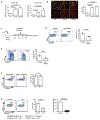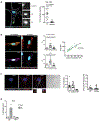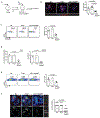Follicular Dendritic Cell Activation by TLR Ligands Promotes Autoreactive B Cell Responses
- PMID: 28099860
- PMCID: PMC8140609
- DOI: 10.1016/j.immuni.2016.12.014
Follicular Dendritic Cell Activation by TLR Ligands Promotes Autoreactive B Cell Responses
Abstract
A hallmark of autoimmunity in murine models of lupus is the formation of germinal centers (GCs) in lymphoid tissues where self-reactive B cells expand and differentiate. In the host response to foreign antigens, follicular dendritic cells (FDCs) maintain GCs through the uptake and cycling of complement-opsonized immune complexes. Here, we examined whether FDCs retain self-antigens and the impact of this process in autoantibody secretion in lupus. We found that FDCs took up and retained self-immune complexes composed of ribonucleotide proteins, autoantibody, and complement. This uptake, mediated through CD21, triggered endosomal TLR7 and led to the secretion of interferon (IFN) α via an IRF5-dependent pathway. Blocking of FDC secretion of IFN-α restored B cell tolerance and reduced the amount of GCs and pathogenic autoantibody. Thus, FDCs are a critical source of the IFN-α driving autoimmunity in this lupus model. This pathway is conserved in humans, suggesting that it may be a viable therapeutic target in systemic lupus erythematosus.
Keywords: CD21; CD35; DAMP; TLR7; autoimmunity; follicular dendritic cells; immune complex; interferon-α; systemic lupus erythematosus.
Copyright © 2017 Elsevier Inc. All rights reserved.
Conflict of interest statement
COMPETING FINANCIAL INTERESTS
R.H., N.M., and G.C. are employees of MedImmune, LLC
Figures






References
-
- Allen CD, Okada T, Tang HL, and Cyster JG (2007b). Imaging of germinal center selection events during affinity maturation. Science 315, 528–531. - PubMed
-
- Allman D, Lindsley RC, DeMuth W, Rudd K, Shinton SA, and Hardy RR (2001). Resolution of three nonproliferative immature splenic B cell subsets reveals multiple selection points during peripheral B cell maturation. Journal of immunology 167, 6834–6840. - PubMed
Publication types
MeSH terms
Substances
Grants and funding
LinkOut - more resources
Full Text Sources
Other Literature Sources
Medical
Molecular Biology Databases

